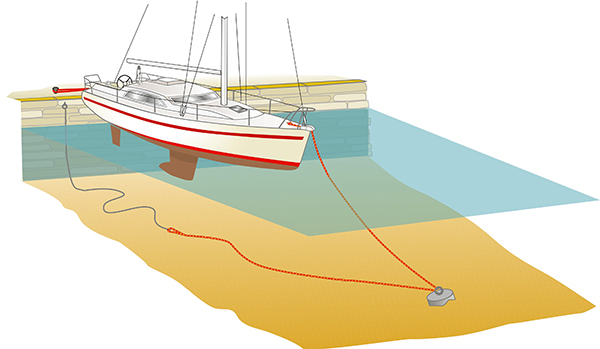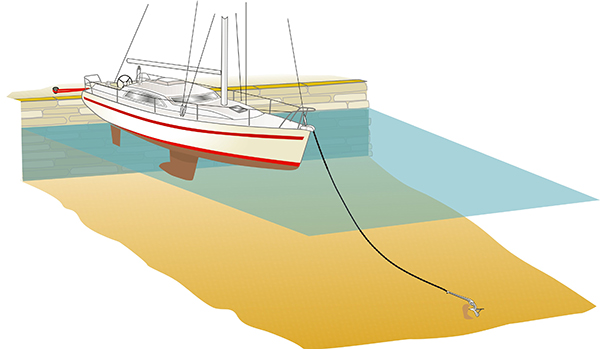Med mooring: stern-to
Master the basics of Med mooring in time for your summer holidays
.png)
Mediterranean mooring, also known as ‘Med mooring,’ is a technique for securing a vessel to a pier or dock. It takes its name from the traditional Mediterranean custom of mooring stern-to along a town quay or marina. This method works well in the Med as there is very little tide, and it is a more efficient use of dock space.
If you’re planning a charter holiday or to take your boat to the Med this summer, you’re likely to encounter Med mooring in destinations like Greece, Croatia and Italy.
Med mooring
Mediterranean mooring is usually stern-to the quay, allowing for easy access ashore. However, if unsure of the water’s depth, going bows-to will keep your drives in deeper water.
Stern lines are used to stay close to the quay or pontoon, and either an anchor or a line from the bow helps hold the boat away.
A passerelle or wooden plank is usually carried by the boat and set down when leaving your vessel to go ashore.
When mooring abroad, you should talk to the marina or town quay to agree a berth or chose a preferred spot. Between other vessels is preferable. You’ll also need to confirm how to secure the bow, either with lazy lines or an anchor.
Here are a few basics to help you with Med mooring stern-to…
Stern-to with lazy lines

Lazy lines
Lazy lines are used in busy harbours and marinas where multiple anchors would become fouled. Instead of the anchor holding the bow away, the bow is connected to a heavy bow line, which is pre-attached to a concrete block on the seabed.
The bow line is also attached to a lighter ‘lazy line’ leading to the quayside/pontoon. The lazy line is retrieved from the wall and led to the bow and the heavier line hauled in and tied off.
Preparation
Rig up the fenders on either side and at the stern. Follow by rigging two stern lines, they should be long enough to go ashore and come back to the boat.
The approach
Reverse towards the quay/pontoon and connect windward stern line to quay/pontoon first.
Pick up the lazy line, lead it to the bow and tie off. Connect the second stern line and then adjust bow and stern lines.
To hold the boat in position once the windward stern-line is attached use small nudges ahead on the leeward engine. If you have a single engine boat, turn the wheel to windward and use ‘ahead’ to keep the bow up to wind.
Often the stern lines are eased, and the bow line is re-tightened. The stern lines are then hauled in taught.
A tight bow line reduces the chance of the stern bashing the quay or pontoon. Springs which are diagonal lines from either quarter to the quay can stop the stern from moving sideways.
Stern-to under anchor

In harbours with no lazy lines, you’ll need to drop your anchor.
Preparation
Rig up fenders on both sides and a large fender on the stern. Once complete, rig a stern line from both quarters.
Prepare the anchor to drop, ensuring that the chain is either flaked out on the deck or untangled in the chain locker, so it runs freely. If possible, look at where other vessels anchor chains are laid and don’t cross them with yours.
The approach
Reverse towards your intended berth, start from a good distance away to ensure the vessel is under control. When you get to roughly four boat lengths away from the quay, drop the anchor and ease out chain, this needs to runout easily.
When you get to one boat length away from the quay, stop easing the chain so that any kinks are removed, and the anchor digs in. Be ready to ease out more chain if required.
Connect the windward stern line to shore, followed by the leeward stern line. Once positioned the correct distance from the quay, take the strain up on the chain.
To ensure the stern stays away from the quay/pontoon, often the stern lines are eased, and the chain tightened.
.png)
Crosswinds
In a crosswind it may be necessary to reverse into wind initially to get steerageway. It is imperative that the chain runs out freely or there is potential it will snub the bow and alter or ruin your approach towards the berth.
When slightly upwind of the gap, drop the anchor and reverse into the space. Ensure the leeward side is protected with fenders in case you drift onto the downwind boat.
Onshore wind
If the wind is on the bow, treat stern-to Med mooring as a normal anchoring exercise.
Drop the anchor four-boat lengths out and gently reverse into the gap with the stern lines ready.
Once you are roughly one boat length away from the quay, snub the anchor so that it digs in. You can then finish by connecting the stern lines.
Enhance your skills
Gain a better understanding of Med mooring and boat handling through our training courses or take a look at our RYA Boat Handling for Sail and Power eBook.
